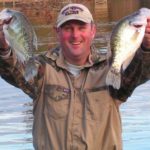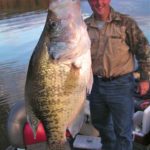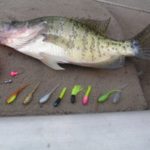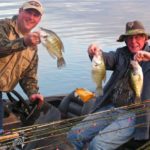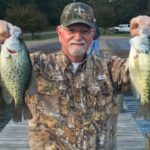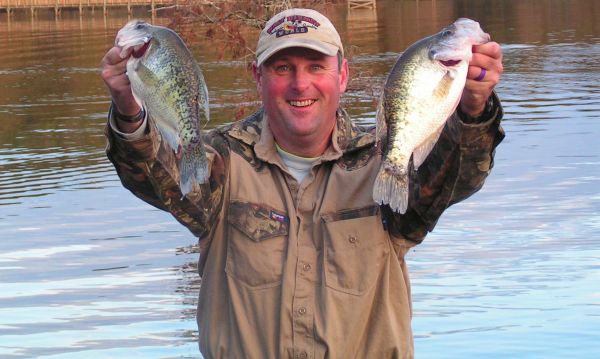
If you’re looking for this die-hard North Louisiana angler, it’s a safe bet he’s on the water chasing crappie. Here’s a look at how he learned to catch more perch.
Picture this, if you will: About 50 crappie fishermen of all sizes and shapes are all gathered in the same area of the lake in different boats, wearing different-colored clothes and using different baits, all fishing with jig poles.
Where’s Waldo? There he is, slow-trolling his spider rig through a school of Cypress Lake crappie and talking in a booming voice that is unmistakable.
Actually, it’s Doc Waldo, and he’s really Mark Weldon of Bossier City, a gas lease operator for GeoSouthern.
Formerly an outdoorsman who hunted anything there was a season for and fished for anything that swam, Weldon is now focused on one thing — catching crappie.
A lot of what Weldon has learned about the sport came from Internet. About 10 years ago he was searching the web for information on how to catch white perch (that’s what north Louisiana anglers used to call crappie before they finally gave in to the “crappie” craze).
He found a site called Crappie.com, and started asking questitons of veteran crappie anglers on the site.
“It was amazing,” Weldon said. “I found out that one of the guys I was talking to, Cajun Dave, lived about two blocks away.
“We hooked up and shared information. That’s happened with dozens of others, and I can’t tell you how much I’ve learned.”
He has also taught a thing or two to others, both online and on the lake. Mark also loves to take his kids, Brody, Maggie and Gracie, fishing, too.
Over the years, he has fished numerous North Louisiana lakes, but he is always drawn back to his favorite home lakes, Black Bayou Reservoir and Cypress Lake Reservoir located just outside of Benton.
The two lakes are side by side, separated by Parks Road.
Cypress is the largest of the two, and is mostly open without a lot of treetops and submerged structure. Black Bayou has more cypress trees, and is loaded with tops, brush piles and underwater structure.
“The biggest difference in fishing on the two (lakes) is that Black Bayou has 80 percent black crappie and Cypress has 90 percent white crappie,” Weldon said. “I’m not sure why, but I think it is because the black crappie like more cover to spawn in and Black Bayou certainly has that.”
When it comes to catching fish, his favorite summer method is to fish a jig or shiner under a slip cork 8 to 10 feet deep on Black Bayou all the way into July.
He finds deeper areas with 16 to 18 feet of water and locates the fish suspended at the 8- to 10-foot range.
There are usually a lot of fish on the graph showing near the bottom, but Weldon said those fish are usually inactive and hard to catch.
The ones about halfway down the water column, on the other hand, are looking for something to eat.
One of his favorite areas is under the bridge.
Weldon fishes shiners more in the summer than he does jigs, but when he does turn to artificials, he offers fish small, pink-headed jigs with blue thunder or electric chicken plastic trailers.
On Cypress, he likes to spider rig with more rods in the open water.
The fish there relate to the same depths of water in the summer as Black Bayou.
One of the popular areas is out in front of the dam.
But if you can locate some of the scattered tops on your electronics, they hold fish this time of year, too.
One growing trend on Cypress Lake is the use of trolling with crankbaits. People are learning that you can long-line crankbaits just like trolling for bass, and there are fish to be caught.
Welcon likes to troll with solid-pink Bandit 300 lures when he’s fishing on Cypress Lake.
Electronics are important on both lakes because, unlike in the winter when you can spot big wads of shad in the water, bait is more spread out in the summer.
The key is finding those scattered shad and the crappie below them on the fish locater. That is where you want to fish.
Weldon has several other favorite crappie lakes, but because of driving distance he just doesn’t get to them as often as he would like.
“Lake D’Arbonne is absolutely one of the best crappie lakes around,” he said. “If it were closer, I’d fish nowhere else. Toledo Bend is also an awesome fishery, but it’s a two-hour drive and there is a lot of water to cover.
“There’s another lake — Black Lake at Hosston that I love to fish. It gets tough in the summer because of all the grass, but if you can punch through it, there are loads of crappie there.”
The die-hard angler also has caught crappie at Lake Claiborne near Homer.
One thing that makes D’Arbonne a favorite is the fact that Doc Waldo helps head up the annual Crappie.com gathering there each fall, with between 70 and 100 fishermen gathering to fish, and share information and stories.
“If I could only tell someone who wanted to learn to crappie fish one thing, it would be to find somebody who knows what they are doing and ask them a million questions,” Weldon said. “I tell you, crappie fishermen are the most-giving and sharing, cordial fishermen in the world.
“That’s how I learned, by chatting with others on Crappie.com, and by meeting and going with other crappie fishermen. Tag along in the backseat of their boat or ask if you can trail them on the lake. Watch what they are doing: That’s the best way to learn.”
